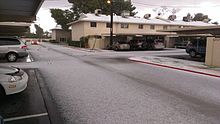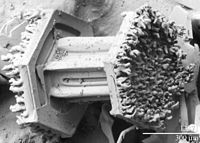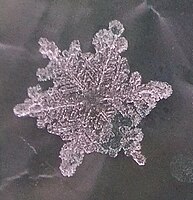Graupel

| Part of a series on |
| Weather |
|---|
|
|
Graupel (
Graupel is distinct from hail and ice pellets in both formation and appearance. However, both hail and graupel are common in thunderstorms with cumulonimbus clouds, though graupel also falls in winter storms, and at higher elevations as well. [3] The METAR code for graupel is GS.
Formation


Under some
As graupel falls, it often deforms into a conical shape. This conical shape, in turn, determines which direction it falls and how far it travels as it falls. Small graupel particles with a base diameter less than 1mm generally fall with the conical base down, but if the particle is between 1mm and 3mm persistent oscillations around the center of the conical base appear, and if larger than 3mm the graupel particle will start to tumble. As the base diameter increases, conical graupel particles generally further horizontally from where it initially fell.[5]
Graupel was formerly referred to by meteorologists as "soft hail." Graupel is distinguishable from true hail in both the shape and strength of the pellet and, in some cases, the circumstances in which it falls. Ice from
Microscopic structure
The frozen droplets on the surface of rimed crystals are difficult to see even when zoomed in, and the topography of a graupel particle is not easy to record with a
However, observations of snow crystals with a low-temperature scanning electron microscope (LT-SEM) clearly show frozen cloud droplets measuring up to 50 μm (0.002 in) on the surface of the crystals. The rime has been observed on all four basic forms of snow crystals, including plates, dendrites, columns and needles. As the riming process continues, the mass of frozen, accumulated cloud droplets eventually obscures the form of the original snow crystal, thereby giving rise to graupel.[4]
-
Graupel encasing and hiding a snow crystal from view
-
Rime on both ends of a columnar snow crystal
Graupel and avalanches
Graupel commonly forms in high-altitude[quantify] climates and is both denser and more granular than ordinary snow, due to its rimed exterior. Macroscopically, graupel resembles small beads of polystyrene. The combination of density and low viscosity makes fresh layers of graupel unstable on slopes, and layers of 20–30 cm (8–12 in) or higher present a high risk of dangerous slab avalanches. In addition, thinner layers of graupel falling at low temperatures can act as ball bearings below subsequent falls of more naturally stable snow, rendering them also liable to avalanche or otherwise making surfaces slippery.[7] Graupel tends to compact and stabilise ("weld") approximately one or two days after falling, depending on the temperature and the properties of the graupel.[8]
Gallery
-
Snowflakes can turn into graupel
-
Almost graupel
-
Graupel in shape of snowflake
See also
- Sleet – term variously used for frozen precipitation
- Freezing rain
- Ice pellets
References
- ^ "Graupel - Definition". Merriam-Webster Dictionary. Merriam-Webster. Retrieved 15 Jan 2012.
- ^ "Glossary". International Cloud Atlas. World Meteorological Organization. 2017. Retrieved 2019-09-03.
- ^ "What in the world is graupel?". KUSA.com. April 30, 2019. Retrieved 2022-05-16.
- ^ U.S. Department of Agriculture Electron Microscopy Unit, Beltsville Agricultural Research Center. Archived from the originalon 2017-07-11. Retrieved 2020-03-23.
- .
- About.com.
- ^ LaChapelle, Edward R. (May 1966). "The Relation of Crystal Riming to Avalanche Formation in New Snow". Department of Atmospheric Sciences, University of Washington. Archived from the original on 2008-12-06.
- ^ "Graupel". American Avalanche Association. Archived from the original on 2010-05-04.
External links
Dictionaries
- 3 results for:graupel. Dictionary.com, accessed September 12, 2006.
- Graupel. Merriam-Webster Online Dictionary, accessed September 12, 2006.
Weather glossaries
- Weather Glossary, G. The Weather Channel, accessed September 12, 2006.
- All About Snow. National Snow and Ice Data Center (NSIDC), accessed September 12, 2006.
- Terms used by meteorologists, forecasters, weather observers, and in weather forecasts. National Oceanic and Atmospheric Administration (NOAA), accessed September 12, 2006.
- About.com Weather Glossary. Weather at About.com, accessed December 21, 2008.





